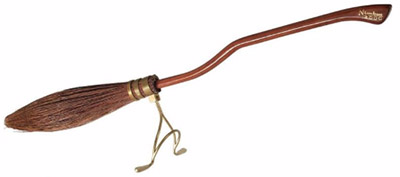
|
|
Harry Potter’s broom |
I enjoy many stories, novels, and movies based on magic and magicians—the kind where magic is a real force, not a stage performance. But I have always resisted writing about magic as if it was real and not, in Arthur C. Clarke’s words, a “sufficiently advanced technology.”1
The problem, as I see it, is that I have too practical and inquiring a mind. Being the son of a mechanical engineer, grandson of a civil engineer, having worked all my life with engineers and scientists, and being good at asking questions and keeping my ears and mind open, I have a feel for the way things work in the real world. Which means I can just about smell a technical problem without having to take measurements.
So … Harry Potter’s broom raises an interesting question. In the Wizarding World, is it the broom that flies, and the person simply steers or wills it to fly in a certain direction at a certain altitude? Or is it the person that flies, and the broom is simply an adjunct, a supplement to his or her powers, perhaps functioning as some kind of talisman?
The reason I ask is one of balance. A person perched on top of a broom has his or her center of mass positioned above the shaft of the broomstick.2 In that condition—as I know from personal experience with the inertial dynamics and all the postures and gestures involved in riding a motorcycle—your balance would be severely proscribed. Like a ship whose center of gravity and center of buoyancy become misaligned, the whole rig will tend to turn over.
So why doesn’t a witch or wizard riding a broomstick—either in the Harry Potter world or in the traditional Salem and Halloween sense—with only her or his legs hanging below the shaft, and the rest of the body’s mass above it, not turn over? Why don’t we see these people flying upside down and hanging onto the broom for dear life?
The question is pertinent because I don’t think that—to the extent authors who deal in magic and flying broomsticks are actually thinking this matter through—the person is flying and only using the broom as a talisman. We’ve seen comic scenes, particularly during Quidditch games, where a player is knocked off his or her broom and must hang on, two-handed and legs flailing, underneath the floating broom while he or she tries to climb back aboard. Clearly, the broom and not the human is doing the actual lifting and flying.
So why isn’t the rider flying upside down? Does the broom have a preferred side or orientation? Do the laws of physics cease to operate in the vicinity of the broomstick?3 Or does it have something to do with the positioning of the rider’s hands and legs and the strength of their grip on the shaft?
It’s all a mystery, as magic should be. Still, inquiring minds want to know.
1. The whole quote is “Any sufficiently advanced technology is indistinguishable from magic.” And that is the basis of much good science fiction.
2. Don’t be fooled by the wire stirrups in the picture, as if they anchored the rider in any preferred position. Mass is mass and finds its own center of gravity. Just ask any horseback rider who, with or without stirrups, experiences a broken saddle girth.
3. Well, of course!
No comments:
Post a Comment